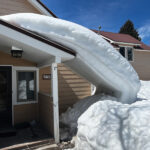Interestingly enough, most roofs are installed outside and as such are likely going to be exposed to an active and sometimes angry environment.
Environmental factors to considerations when selecting roofing

Rust damage
In conversations with customers and owners, discussions of aesthetics can sometimes proceed the discussion of long-term performance of metal roofing and cladding solutions. As a metal roofing and cladding manufacturer, we get it, you can do lots of cool stuff with metal, but at some point, the specifiers, engineers and designers need to roll up their collective sleeves and do some nerd work. (Please note that sometimes nerds wear short sleeves and as such would not require sleeve rolling; we hate to generalize.) There are several environmental factors that need to be considered when selecting the appropriate panel, substrate, engineered attachment and finished coating.
Fire
Most people are well aware that metal does not burn and just as many likely understand that hot metal can transfer copious amounts of heat (see touching a hot pan or sliding on a hot playground slide). In any case, while an excellent non-flammable solution, it is important to understand the basic testing and requirements for fire resistance when designing a roof system.
FM Global, Underwriters Laboratories and other agencies provided detailed approved systems that meet and exceed the specific requirements for flame spread, burning brand, intermittent flame and flying brand. In most cases metal roofs are metal roofs with regard to fire testing. Typically, the driving factor of performance is the substrate, where combustible decks need to be considered in overall system performance. A metal roof installed directly over a plywood, OSB or nail base, with only an underlayment between (nailed or adhere), is usually an unrated system. Meaning it does not pass any fire rating test.

Wind damage
Wind
Wind blows. And in many places, it blows harder than others. There are standard inclusions that are a key part of industry standards to measure the specific wind and wind-driven rain resistance of metal roof and wall panels. The most appropriate test for metal panels is likely ASTM E 1592, which allows for not only the measurement of the seam performance but also the edge conditions. Bottom line, it is a requirement to understand the panel performance as a starting point for qualifying your design for the specific conditions it will face.
The next required step (at least by code in reference to ASCE 7) is to determine the wind load of the specific building structure. Wind uplift calculations and engineering are essential for appropriate system design.
Specific environmental conditions to understand include location of the building in reference to other structures and topography, building usage, height of the building, slope of the roof (and wall system), and geographic location of the structure. Qualified engineers and manufacturers can review these conditions and can provide accurate information (calculations) on the allowable material gauge, panel widths and clip (attachment) spacing.
Geography
Understanding the specific conditions of your geographic location is critical in designing your roof and wall cladding systems. (You do not get a free pass on this even if Sam Cooke claims it may end up being a “Wonderful World”). Question one, are you near a large body of salt water? You can typically determine this by looking at a map or examining how relaxed the local inhabitants are. Salt water can do a number on incorrectly designed metal roofing and wall cladding products. The galvanic effect and rust formation are greatly accelerated by the presence of salt water and salt spray. While there are specific coatings that can extend the life of metal components, deterioration can be controlled by selecting the correct substrate.
Aluminum is always the material of choice for coastal applications. Aluminum does rust, but in most cases aluminum rust is limited to surface formation and non-penetrating rust and can be greatly mitigated using a coastal paint system. Natural metal, such as zinc and copper, will age more quickly in coastal environments. In some cases, this patina effect is desired, but it is important to understand the patina process is a natural effect and somewhat out of control. Every job is manageable, collaboration between engineers, designers, architects, owners, and material providers creates the best result.
Understanding the desired look and performance and doing the nerd work upfront is best in establishing long-term performance. Saving money (or time) can lead to greater expense in the future or premature failure. But when you get it right “what a wonderful world it will be.”
Jay Mulligan is area manager, and Joe Mellott is vice president, of Innovative Metals Co. Inc. (IMETCO), Norcross, Ga. To learn more, call (415) 971-2739, or visit www.imetco.com.

Wind damage






